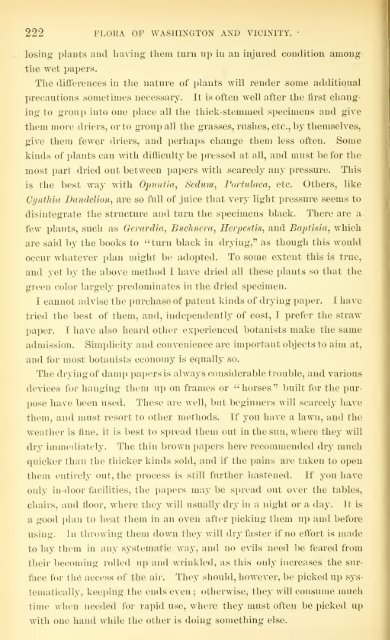Bulletin - United States National Museum - Smithsonian Institution
Bulletin - United States National Museum - Smithsonian Institution
Bulletin - United States National Museum - Smithsonian Institution
You also want an ePaper? Increase the reach of your titles
YUMPU automatically turns print PDFs into web optimized ePapers that Google loves.
222 FLORA OF WASHINGTON AND VICINITY. •<br />
losing plants and having them turn up in an injured condition among<br />
the wet papers.<br />
The differences in the nature of plants will render some additional<br />
precautions sometimes necessary. It is often well after the first chang-<br />
ing to group into one place all the thick-stemmed specimens and give<br />
them more driers, or to group all the grasses, rushes, etc., by themselves,<br />
give them fewer driers, and perhaps change them less often. Some<br />
kinds of plants can with diflBculty be pressed at all, and must be for the<br />
most part dried out between papers with scarcely any pressure. This<br />
is the best way with Opuntia, Sedum, Portulaea, etc. Others, like<br />
Cynthia Dandelion, are so full of juice that very light pressure seems to<br />
disintegrate the structure and turn the specimens blaclv. There are a<br />
few plants, such as Gerardia^ Buchnera, Herpestis, and Bapfina, which<br />
are said by the books to "turn black in drying," as though this would<br />
occur whatever plan might be adopted. To some extent this is true,<br />
and yet by the above method I have dried all these plants so that the<br />
green color largely predominates in the dried specimen.<br />
I cannot advise the purchase of patent kinds of drying paper. I have<br />
tried the best of them, and, independently of cost, I prefer the straw<br />
paper. I have also heard other experienced botanists make the same<br />
admission. Simplicity and convenience are important objects to aim at,<br />
and for most botanists economy is equally so.<br />
The drying of damp papers is always considerable trouble, and various<br />
devices for hanging them up on frames or "horses" built for the pur-<br />
pose hav^e been used. These are well, but beginners will scarcely have<br />
them, and must resort to other methods. If you have a lawn, and the<br />
weather is fine, it is best to spread them out in the sun, where they will<br />
dry immediately. The thin brown papers here recommended dry much<br />
quicker than the thicker kinds sold, and if the pains are taken to open<br />
them entirely out, the process is still further hastened. If you have<br />
only in-door facilities, the papers may be spread out over the tables,<br />
chairs, and floor, where they will usually dry in a night or a day. It is<br />
a good plan to heat them in an oven after picking them up and before<br />
using. In throwing them down they will dry faster if no effort is made<br />
to lay them in any systematic way, and no evils need be feared from<br />
their becoming rolled up and wrinkled, as this only increases the sur-<br />
face for the access of the air. They should, however, be picked up systematically,<br />
keeping the ends even ; otherwise, they will consume much<br />
time when needed for rapid use, where thej^ must often be picked up<br />
with one hand while the other is doing something else.

















